Red-and-blue Lories: Rehabilitation and Release
Trafficking for the wild bird trade has severely affected Red-and-blue Lory (Eos histrio) populations. The WPT supports the release and reintroduction of Red-and-blue Lories from in-country partner Tasikoki Wildlife Rescue and Education Centre, with the backing of the North Sulawesi Provincial Department for Conservation of Natural Resources (BKSDA). The aim is to release birds caught in trade to lay the groundwork for the species’ resurgence on islands where it has gone extinct. The WPT will train staff at the centre on appropriate release disease testing and health and body condition assessments for the birds. A refurbished aviary on Karakelang, used previously to release red-and-blue lories in the protected forest area of Beo, will serve as a staging ground for this effort. The soft release process allows the birds to habituate to their surroundings before release. Afterwards, the aviaries remain accessible, and supplemental feeding platforms nearby ensure the birds have the best chance of thriving once released. While under Tasikoki’s care, they are also being acclimatised to artificial nests to increase their chances of successfully breeding post-release.
A WPT Parrot Welfare Specialist is supporting and training partners Pusat Informasi Sampiri (PIS) and the North Sulawesi Provincial Department for Conservation of Natural Resources (BKSDA) on release and post-release monitoring protocols in preparation for future releases.
IUCN/CITES Status: Endangered / Appendix I
Population: As few as 1000; nominate of species possibly extinct on Sangihe Is.
Range: Native to Sangihe, Talaud and Nanusa Islands, Indonesia.
Natural history:
Red-and-blue Lories are found in forest and cultivated areas up to 1250 m (4100 ft). Their diet includes coconut, and the fruit and nectar of various trees. Insects are also taken. They are most commonly seen flying in groups of up to 8 birds. Large, very vocal numbers gather together to roost.

